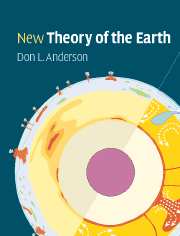Book contents
- Frontmatter
- Contents
- Preface and Philosophy
- Abbreviations and acronyms
- Part I Planetary perspective
- Part II Earth: the dynamic planet
- Part III Radial and lateral structure
- Part IV Sampling the Earth
- Part V Mineral physics
- Part VI Origin and evolution of the layers and blobs
- Part VII Energetics
- Chapter 26 Terrestrial heat flow
- Chapter 27 The thermal history of the Earth
- References and notes
- Appendix
- Index
Chapter 27 - The thermal history of the Earth
Published online by Cambridge University Press: 05 June 2012
- Frontmatter
- Contents
- Preface and Philosophy
- Abbreviations and acronyms
- Part I Planetary perspective
- Part II Earth: the dynamic planet
- Part III Radial and lateral structure
- Part IV Sampling the Earth
- Part V Mineral physics
- Part VI Origin and evolution of the layers and blobs
- Part VII Energetics
- Chapter 26 Terrestrial heat flow
- Chapter 27 The thermal history of the Earth
- References and notes
- Appendix
- Index
Summary
Man grows cold faster than the planet he inhabits.
Albert EinsteinStarting with Kelvin there have been many controversies and paradoxes associated with the evolution of the Earth. These are not faith-based controversies, in the ordinary sense; they are based on calculations and assumptions – which are a form of faith. Present-day heat flow is determined by the amount and distribution of radioactive elements, their secular decline with time, the delay between heat production and its appearance at the surface, secular cooling of the interior, and a variety of minor sources of heating which are usually overlooked. Chemical stratification of the mantle slows down the cooling of the Earth; the upward concentration of radioactive elements reduces the time between heat generation and surface heat flow. The initial conditions of the Earth cannot be ignored; they have not been forgotten.
Continents divert mantle heat to the ocean basins and, in addition, tend to move toward cold downwellings, thereby protecting their cold keels. Surface conditions – including the thickness of plates – and mantle viscosity control convective vigor and cooling history of the mantle. A global accounting of the heat lost from the interior by hydrothermal processes at the surface is a lingering issue. A chemically layered mantle with upward concentrations of the radioactive elements, shallow return flow, and a low-viscosity asthenosphere is the most plausible model of mantle dynamics. The migration of ridges and trenches is an important aspect of thermal history and geodynamics.
- Type
- Chapter
- Information
- New Theory of the Earth , pp. 349 - 355Publisher: Cambridge University PressPrint publication year: 2007



